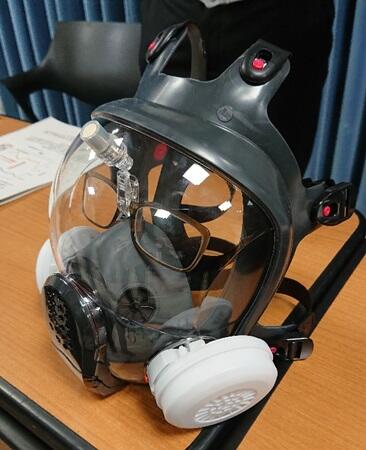It has become possible to wear a full‐face type respirator that allows you to handle radioactive and other materials even while wearing glasses. The Plutonium Fuel Development Center, Nuclear Fuel Cycle Engineering Laboratories of the Japan Atomic Energy Agency (JAEA) has developed magnet‐fixing glasses for full‐face type respirators. General Manager Hiroshi Kikuno at the Center said, "The temples of glasses compromise the airtightness of full‐face respirators. As a result, people wearing glasses had to be excluded from inspection work, but this would result in uneven exposure, which is why we developed these glasses. The new glasses can be also applied in various fields, such as firefighting." The product is marketed by KOKUGO, which co‐developed the product.

The full‐face type respirator covers the face with a high degree of adhesion to ensure an airtight interior. If these respirators are worn while wearing glasses with temples, there will be a gap between the face and the respirator, and the airtightness of the respirator will be compromised. Actual measurements of the rate of leakage from the respirator for persons wearing glasses showed that the airtightness was reduced by more than two orders of magnitude.
Due to this, special glasses were developed jointly with KOKUGO, a manufacturer that handles full‐face type respirators. The eyeglass part of the respirator has no temples, and the frame (lens, rim and bridge) comprises an integrated structure made of plastic. Seven types of prescriptions are available for near‐sightedness and presbyopia, enabling many people to use the respirator.
Instead of temples, the glasses include a gripping mechanism for support, where the grip can be bent to any angle, and the length can be adjusted by adding another joint component. The grip uses a magnetic system to fix the glasses securely to the front of the full‐face type respirator and to allow adjustment of the position of the glasses. The glasses are fixed in place before the full‐face type respirator is worn, and the outer magnets can be moved after the respirator is worn to allow for subtle adjustments.
Joji Tachihara commented: "Contact lenses are one solution, but they don't work well during pollen season, and some people can't wear them. Therefore, we adopted the eyeglass method this time around."
The price, excluding tax, is 9,500 yen for a set of glasses and the gripping mechanism, and 3,000 yen for the gripping mechanism alone. At JAEA's MOX fuel fabrication and development facility, 120 units were deployed for periodic inspections and emergencies. The new glasses can be applied to any type of full‐face type respirator, and because of their high versatility, they are likely to be used at facilities that use full‐face type respirators in Japan and overseas, as well as at firefighting facilities and other disaster‐prevention organizations.
This article has been translated by JST with permission from The Science News Ltd. (https://sci-news.co.jp/). Unauthorized reproduction of the article and photographs is prohibited.




